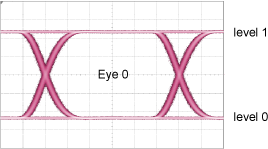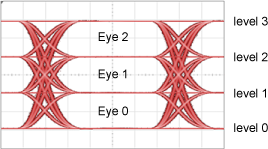:MEASure:JITTer:LEVel
Command Syntax
:MEASure:JITTer:LEVel
Query Syntax
:MEASure:JITTer:LEVel?
Description
Measures the jitter sampling level, which is the amplitude at which jitter measurements are made. The command query returns the setting without displaying the value in the table. Jitter sampling level is specified as a percentage, custom, or average value using the :MEASure:JITTer:DEFine:LEVel:TYPe command. If a percentage or average value is specified, the :MEASure:JITTer:LEVel command returns the equivalent vertical value that is used. For example, for a setting of 50%, the displayed or returned value might be 10E-3, depending on the actual signal.
To selects the eye in the PAM4 eye diagram on which to return the measurement, use the :MEASURE:JITTer:LEVel:EYE command.
For NRZ measurements, moves the Level measurement to the top of the Amplitude table. Displays the measurement if it is not already shown on the table. The query form of the command returns the measured value.
NRZ Waveform

PAM4 Waveform

Measurement Identification
Avoid subtle programming errors! To ensure that the correct measurement is installed or queried, always explicitly identify a measurement when installing a measurement or querying a measured value, status, or detail. To identify a measurement, specify the measurement's source waveform (:SOURce child command). With some measurements, you may also need to specify other identifying values. Generally, when selecting a measurement using FlexDCA's GUI, if a dialog appears prompting you to select values, you should explicitly specify these values when remotely identifying the measurement. More information.
For example, to return the status of the measurement, :MEASure:JITTer:LEVel:
flex.write(':MEASure:JITTer:LEVel:SOURce CHAN1A')
if flex.query(':MEASure:JITTer:LEVel:STATus?') == 'CORR';
measurement = flex.query(':MEASure:JITTer:LEVel?')
else:
details = flex.query(':MEASure:JITTer:LEVel:STATus:DETails?')
reason = flex.query(':MEASure:JITTer:LEVel:STATus:REASon?')
Child commands for measurement identification:
:MEASure:JITTer:LEVel:SOURce
This measurement cannot be accessed from FlexDCA's user interface. It is only available via this programming command.
Example Command Sequence
:SYSTem:MODE JITTer :MEASure:JITTer:DEFine:LEVel:TYPe AVERage :MEASure:JITTer:LEVel:SOURce CHAN1A :MEASure:JITTer:LEVel?
Measurement Ready?
To confirm that the measurement is ready to read, you can query the measurement's status:
if ('CORR' in Flex.query(':MEASure:JITTer:LEVel:STATus?')):
measurement = Flex.query(':MEASure:JITTer:LEVel?')
If averaging is turned on (:ACQuire:AVERaging), you can also confirm if the measurement result is ready by comparing the number of specified averages (:ACQuire:ECOunt?) versus the number of measurement sweeps that have occurred (:MEASure:JITTer:LEVel:COUNt?). The technique uses the :COUNt? common measurement query. For example,
if (Flex.query(':MEASure:JITTer:LEVel:COUNt?') >= Flex.query(':ACQuire:ECOUNt?')):
measurement = Flex.query(':MEASure:JITTer:LEVel?')
You can also use an acquisition limit lest to test that a number of waveform samples, or pattern acquisitions have completed before returning a measurement. Refer to the :LTESt:ACQuire:CTYPe command.
Common Measurement Child Queries
This command supports the use of the following common measurement queries: :LOCation?, :COUNt?, :MAXimum?, :MINimum?, :MEAN?, and :SDEViation?.